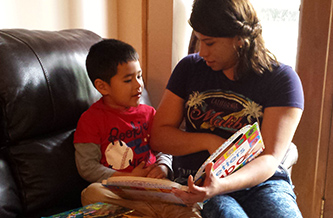How reading to children at a young age expands imaginations, prepares them for success in school and sets them up for future achievements
“You’re never too old, too wacky, too wild, to pick up a book and read to a child.” – Dr. Seuss
 We can all recall a favorite book or story from our childhood — not just for the storyline itself, but how it made us feel. The way it captured our imaginations and let us create an entire world we could explore. Reading aloud to children exposes them this same experience, allowing their imaginations to run free and develop unique scenes as they’re pictured in their mind’s eye.
We can all recall a favorite book or story from our childhood — not just for the storyline itself, but how it made us feel. The way it captured our imaginations and let us create an entire world we could explore. Reading aloud to children exposes them this same experience, allowing their imaginations to run free and develop unique scenes as they’re pictured in their mind’s eye.
Research shows that children who activate their imaginations through being read to or reading themselves develop higher activity in the left-sided parietal-temporal occipital association cortex — the area of the brain that is responsible for cultivating mental images, and deciphering and comprehending verbal cues. This results in both a stronger imagination and fondness of reading.
“Reading stimulates imagination, language and learning,” says Mandi Fisher, program manager for NVFS’ Healthy Families Prince William program. “Reading allows travel without ever leaving your home.”
Apart from stretching a child’s imagination far and wide, reading also prepares children for success in a structured learning environment.
According to the National Education Association, children who are frequently read to are more likely to recognize letters of the alphabet, count to higher numbers, write their own names, and encourage being read to or pretend to read than peers who are not exposed to reading.
“Storybook reading is a wonderful way to introduce new vocabulary to young students,” shares NVFS Head Start teacher Gareba Ali. “Children are also able to practice answering open-ended questions, solve problems and think about what they might do if they were in the story.”
Encouraging children to actively participate in the story while reading is an excellent way to engage them and boost reading comprehension. It can also encourage speech development in children who are dual-language learners or who might be experiencing language delays.
NVFS encourages reading at a young age in our Early Head Start and Head Start programs, as well as our Healthy Families programs, with 92 percent of students in Head Start demonstrating school readiness for kindergarten.
Through these programs, we partner with more than 1,700 families to create nurturing and educational home environments that foster child development.
“Because of NVFS, my children have excelled through its early childhood development programs, including helping my son through developmental delays in speech and motor skills,” shares Ericka Espinosa, an NVFS Head Start parent.
In addition to the educational and developmental benefits, parents and children can strengthen bonds by dedicating time to read together every single day.
“Since I started incorporating reading into the bedtime routine, my child never skips a night and always brings us a book to read, even if dad and I are busy or tired and forget,” shares another Head Start parent. “He helps us remember reading is important.”
Fisher adds, “Reading with young children is a moment of bonding between caregivers and children and acts as an excellent way to unwind and help a child establish a routine.”
So what are you waiting for? Pick up a book, read to a child and witness their growing minds run wild as they explore new places through their larger-than-life imaginations.
You may also like:
Children Spark Conversation on Service and Education

